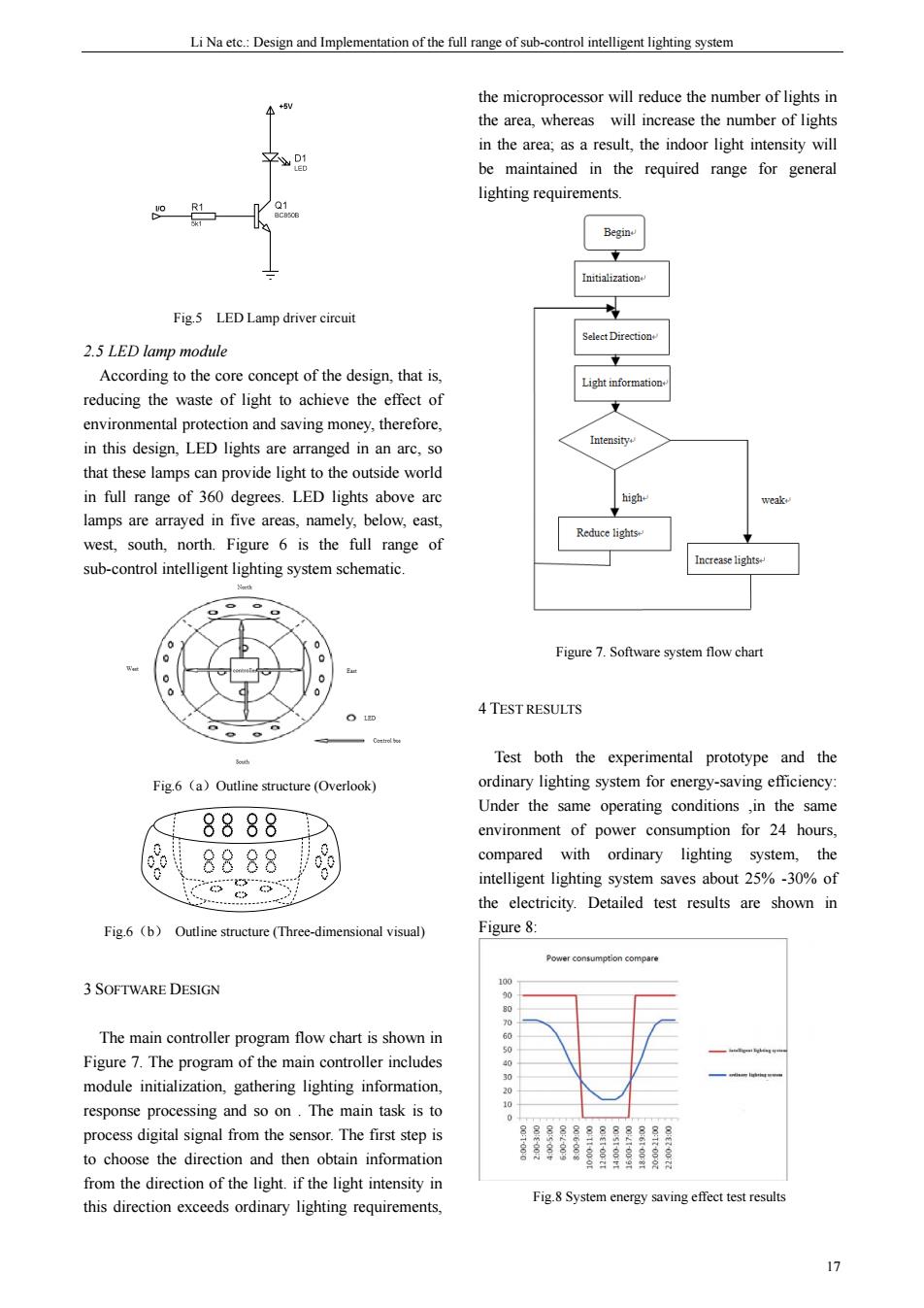正在加载图片...

LiNa et:Design and Implementation of the full range of sub-conro intelligent lighting system the microprocessor will reduce the number of lights in the area,whereas will increase the number of lights in the area,as a result,the indoor light intensity will be maintained in the required range for general lighting requirements Fig5 LEDLamp driver circuit 2.5 LED lamp module According to the core concept of the design.that is reducing the waste of light to achieve the effect of environmental protection and saving money.therefore in this design,LED lights are arr nged in an arc.so that these lampscn provide light to the outside orl in full range of 360 degrees.LED lights above ard lamps are arrayed in five areas,namely,below,east. west,south,north.Figure 6 is the full range of Reduce lighns sub-control intelligent lighting system schematic. Figure7.Software system flow char 4 TEST RESULTS 。。 Test both the experimental prototype and the Fig.6 (a)Outline structure(Overlook ordinary lighting syste energy-s Under the same operating conditions,in the same 8888 environment of power consumption for 24 hours 8888 compared with ordinary lighting system,the intelligent lighting system saves about 25%-30%of the electricity.Detailed test results are shown in Fig.6 (b)Outline structure (Three-dimensional visual) 3 SOFTWARE DESIGN The main controller program flow chart is shown ir Figure 7.The program of the main controller include module initialization.gathering lighting information response processing and so on The main task is to the direction and ther obtain informatior from the direction of the light.if the in this direction exceeds ordinary lighting requirements. Fig.8 System energy saving effect test results 17Li Na etc.: Design and Implementation of the full range of sub-control intelligent lighting system 17 Fig.5 LED Lamp driver circuit 2.5 LED lamp module According to the core concept of the design, that is, reducing the waste of light to achieve the effect of environmental protection and saving money, therefore, in this design, LED lights are arranged in an arc, so that these lamps can provide light to the outside world in full range of 360 degrees. LED lights above arc lamps are arrayed in five areas, namely, below, east, west, south, north. Figure 6 is the full range of sub-control intelligent lighting system schematic. Fig.6(a)Outline structure (Overlook) Fig.6(b) Outline structure (Three-dimensional visual) 3 SOFTWARE DESIGN The main controller program flow chart is shown in Figure 7. The program of the main controller includes module initialization, gathering lighting information, response processing and so on . The main task is to process digital signal from the sensor. The first step is to choose the direction and then obtain information from the direction of the light. if the light intensity in this direction exceeds ordinary lighting requirements, the microprocessor will reduce the number of lights in the area, whereas will increase the number of lights in the area; as a result, the indoor light intensity will be maintained in the required range for general lighting requirements. Figure 7. Software system flow chart 4 TEST RESULTS Test both the experimental prototype and the ordinary lighting system for energy-saving efficiency: Under the same operating conditions ,in the same environment of power consumption for 24 hours, compared with ordinary lighting system, the intelligent lighting system saves about 25% -30% of the electricity. Detailed test results are shown in Figure 8: Fig.8 System energy saving effect test results